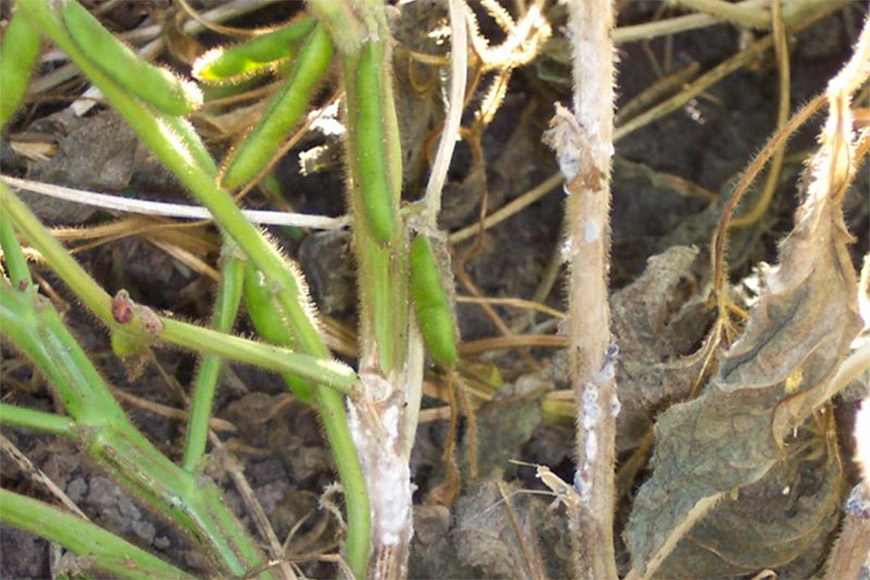7 Tips for Managing Soybean White Mold

If you grow soybeans, you’re likely no stranger to white mold. While it’s impossible to predict exactly how prevalent it will be this season, it pays to be proactive. Fields with a history of the disease should be managed diligently, especially if cool, wet weather continues to exist. Here are some management tips to help you beat soybean white mold to the punch.
To get the most from your fungicide application, I recommend adding MasterLock® adjuvant to the tank. The drift reduction technology and surfactant spreader sticker help enhance spray coverage and adhesion, reduce bounce and get more droplets down into the canopy.
Talk with your trusted advisor about the best white mold management strategy for your soybeans.
All photos are either the property of WinField United or used with permission.
©2024 WinField United. Important: Before use always read and follow label instructions. Crop performance is dependent on several factors many of which are beyond the control of WinField United, including without limitation, soil type, pest pressures, agronomic practices and weather conditions. Growers are encouraged to consider data from multiple locations, over multiple years and to be mindful of how such agronomic conditions could impact results. MasterLock and WinField are trademarks of WinField United.
1. Pay attention to crop rotation.
If you had fields planted with soybeans last year, you’ve probably rotated them to corn or wheat this year, so white mold won’t be a problem. But if you had soybean fields with white mold in 2022 that went to corn in 2023 and are returning to soybeans now, the sclerotia bodies that caused the white mold are still in the soil and could cause an outbreak this year.2. Watch fields with high fertility.
Tall, canopied, high-yielding soybean plants trap more moisture, which is an invitation for white mold. If you have fields with a lot of manure history and high fertility levels in your soil tests — specifically phosphorus — incorporate another management strategy to combat white mold, such as a fungicide application. Don’t cut back on fertilizer.3. Time your fungicide application right.
Sclerotia bodies sprout apothecia, which look like tiny mushrooms and release spores. In nearly all instances, white mold is caused by these spores infecting the soybean plant through a dead flower that has recently pollinated but has not yet formed a pod. The optimal time to apply a fungicide is when you start seeing flowers on your soybean plants and certainly before those flowers start to die. This occurs about midway through the R1 growth stage (initiation of flowering) and before R2 (full flowering).To get the most from your fungicide application, I recommend adding MasterLock® adjuvant to the tank. The drift reduction technology and surfactant spreader sticker help enhance spray coverage and adhesion, reduce bounce and get more droplets down into the canopy.
4. Monitor plant growth for proactive management.
One of the most difficult aspects of white mold management is that you must make decisions about controlling it a month to two months before you see any signs or symptoms. Scouting for apothecia is nearly impossible since they’re very small and short lived. You have to go by the percentage of flowering plants or the calendar date to stay ahead of the disease and make fungicide applications accordingly. By the time you see white mold growing on soybean plant stems, it’s too late to control.5. Do not expect a seed treatment to control your white mold problem.
While certain seed treatments may provide some suppression of white mold, they are not nearly as effective at controlling the disease as a foliar-applied fungicide application. Consider using both as part of a program for white mold control.6. Know the potential of an herbicide.
Applying certain Group 14 herbicides that are also protoporphyrinogen oxidase (PPO) inhibitors can stimulate the systemic acquired resistance (SAR) mode of action, which can help minimize white mold damage if applied at initiation of flowering. Remember, a Group 14 herbicide “burns” the soybean plant to stimulate that white mold response. So, although you may lose some top-end yield, it’s an effective treatment if you do get white mold in your fields.7. Pick a variety with high white mold tolerance.
The best way to manage white mold is through variety selection. If your fields have a history of white mold, be sure to evaluate variety tolerance to white mold.Talk with your trusted advisor about the best white mold management strategy for your soybeans.
All photos are either the property of WinField United or used with permission.
©2024 WinField United. Important: Before use always read and follow label instructions. Crop performance is dependent on several factors many of which are beyond the control of WinField United, including without limitation, soil type, pest pressures, agronomic practices and weather conditions. Growers are encouraged to consider data from multiple locations, over multiple years and to be mindful of how such agronomic conditions could impact results. MasterLock and WinField are trademarks of WinField United.





